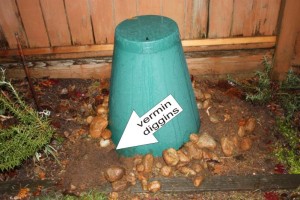We have had the Green Cone in the ground for a little less than a month now. Still waiting.
For the first week or two, we threw all of our kitchen scraps into the Cone: vegetables meat, bones, and a bit of garden weeding. Mostly, I wanted to build a little “reservoir” of waste for the bacteria, nematodes, worms, or whatever to start eating. I sprinkled some starter on every once in a while. It didn’t take long until the “basket” was more than half full, so we cut back to only non-compostables (meat, cheese, etc.), and started throwing the veggie waste back into our garden compost. From this point forward, the plan is to only use the Cone for stuff we don’t want in our composter (stinky stuff like meat, and weeds we collect from the garden that we don’t want in our new soil)
Apparently heat is our friend, and that is why the recommend placing for the cone is in a sunny spot. Unfortunately, we were loading the cone during a week of near-record cold. Temps dipped to the negative double digits, and there was snow on the ground. These seem like less-than-ideal conditions for digestion of the waste, so we may have to wait a bit before we see the volume of material go down. But something is happening, as there is some warmth when you open the Cone to fill it, and snow did not accumulate on the Cone even after a week of really cold temperatures. There is also visible condensation on the Cone on moist mornings. There is no smell next to the closed Cone, and only a hint of garbage smell when you stick your head into the gaping maw of the open Cone.
This morning, we had the first evidence that our regularly scheduled evening visitors have noticed the Cone. A few of the rocks I placed around the cone have been displaced, and something (either our local resident raccoon clan or our local resident skunk) did a little exploratory dig along the side of the cone. The plastic wall and the lip at the bottom of the Cone quickly frustrated them. If I know anything about skunks and raccoons, they will dig a couple of times, and if not rewarded with food, they will file the Cone, stinky or otherwise, under “not a food source”, and stop noticing it. The cobble-sized rocks I put around it will probably help, as they really increase the digging effort. Hopefully they will be bored of the cone by the time the spring plants come up.
Hopefully it will warm up by then as well, and we will start to see some hot digestion action.

Very good article.
I invest in the plastic manufacturing sector. These “green” plastic cones need to be mass produced and sold for a profit to every family in the world that calls themselves “environmentally friendly”.
Soon the day will come when composting without the aid of “green” plastic cone is viewed as unsustainable.
What a beautiful world that will be !
Manufacturing hydrocarbons into long-life plastic products makes a lot more sense than burning them to truck trash to a landfill.
Hmmm. 20lbs of hydrocarbons sequestered into long-life and chemically stable plastic, and I have already saved 20lbs of trash from going to the landfill. Over the life of the product, it may be tonnes of trash. I like the math.
Since you see so much value in plastics, you must really feel bad when others think burning hydrocarbons to move 3000lbs of metal around with us every day is a good idea. So much we could do with the remaining oil that is better than burning it…
Lets do the math then shall we.
1 ton = 2000lbs
You state that in one month you put 20 lbs of “trash” in your “green” plastic cone. That equals 240lbs a year. At your rate of use it will take 8.3 years until you reach the first ton.
I would like to see the chemically stable “green” plastic cone after 8.3 years of exposure to UV radiation and the seasonal temperature variations.
8.3 years is not “long life” even in dog years.